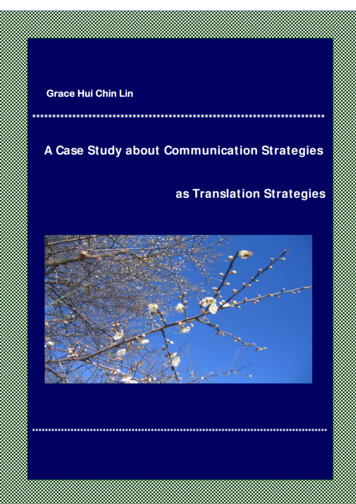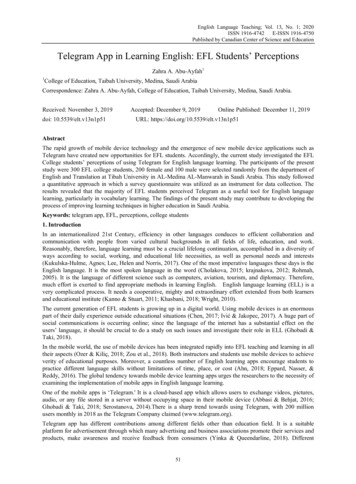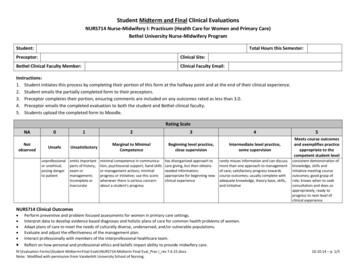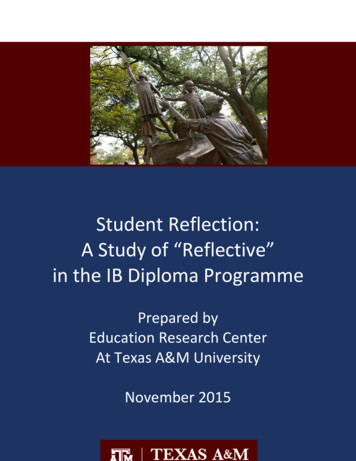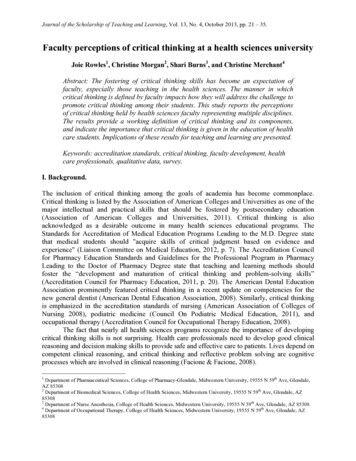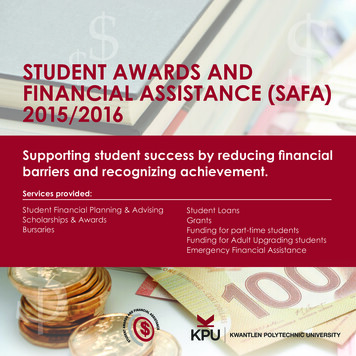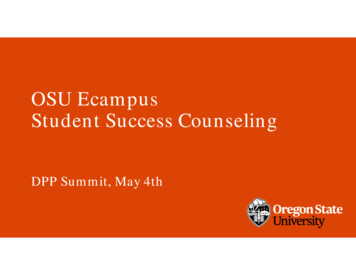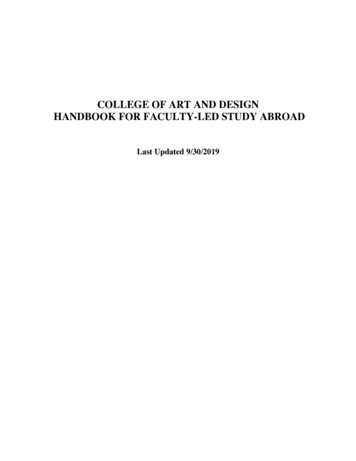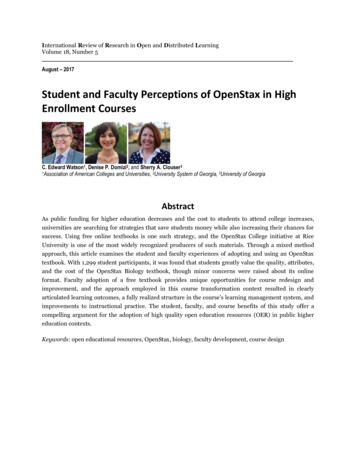
Transcription
International Review of Research in Open and Distributed LearningVolume 18, Number 5August – 2017Student and Faculty Perceptions of OpenStax in HighEnrollment CoursesC. Edward Watson1, Denise P. Domizi2, and Sherry A. Clouser31Association of American Colleges and Universities, 2University System of Georgia, 3University of GeorgiaAbstractAs public funding for higher education decreases and the cost to students to attend college increases,universities are searching for strategies that save students money while also increasing their chances forsuccess. Using free online textbooks is one such strategy, and the OpenStax College initiative at RiceUniversity is one of the most widely recognized producers of such materials. Through a mixed methodapproach, this article examines the student and faculty experiences of adopting and using an OpenStaxtextbook. With 1,299 student participants, it was found that students greatly value the quality, attributes,and the cost of the OpenStax Biology textbook, though minor concerns were raised about its onlineformat. Faculty adoption of a free textbook provides unique opportunities for course redesign andimprovement, and the approach employed in this course transformation context resulted in clearlyarticulated learning outcomes, a fully realized structure in the course’s learning management system, andimprovements to instructional practice. The student, faculty, and course benefits of this study offer acompelling argument for the adoption of high quality open education resources (OER) in public highereducation contexts.Keywords: open educational resources, OpenStax, biology, faculty development, course design
Student and Faculty Perceptions of OpenStax in High Enrollment CoursesWatson, Domizi, and ClouserIntroductionAs public higher education experiences significant decreases in state supported funding, the costsassociated with attending college are increasing, and as a result, so is student loan debt (CBSMoneyWatch, 2012; Schoen, 2015). Textbooks are a key contributor to the overall cost of highereducation, with students at four-year public institutions paying approximately 1,200 for books andsupplies each year (College Board, 2015; Wiley, Green & Soares, 2012). Although student success isdirectly impacted by availability of required learning materials (Buczynski, 2007), when those materialsare not affordable, students may choose not purchase them (Feldstein et al., 2012; Hilton and Laman,2012).At the University of Georgia, students have reported financial stresses, and that has been connected tosuccess rates:Despite the availability of myriad funding opportunities (both merit- and need-based), more thanone-third of all UGA students who responded to the NSSE in 2011 (42% of freshmen and 35% ofseniors) indicated that “after all financial aid is taken into consideration, [they] still have unmetfinancial need that makes pursuing a degree difficult.” Students receiving Federal Pell Grants andsubsidized Federal Direct Loans have a lower graduation rate (8 percent lower) than students whoare not receiving Federal Pell Grants or Federal Direct Student Loans (based on the 2005 Cohortof first-time, full-time freshmen) (University System of Georgia, 2013, p. 280).In an effort to increase retention rates and reduce attrition rates at public institutions across the state, theUniversity System of Georgia (USG) launched its Complete College Georgia initiative in 2012. TheUniversity of Georgia (UGA)—the flagship institution of the USG—has developed a number of strategiesfor facilitating student success. One of these is exploring the use of open educational resources (OER) inplace of expensive textbooks.OER can be defined as “teaching, learning and research resources that reside in the public domain or havebeen released under an intellectual property license that permits their free use or re-purposing by others”(Atkins, Brown, & Hammond, 2007, p. 4). Examples include textbooks, research papers, simulations, andentire courses. The use of OER has been shown to save students money (UMass Amherst Libraries, 2013;Bliss, Robinson, Hilton, & Wiley, 2012). A compelling example is the associate’s degree in businessadministration at Tidewater Community College in Virginia in which all textbooks used by the instructorsare open and free. This is reported to cut the cost of the degree in this community college context by onethird (Hulette, 2013).As faculty consider adopting OER, quality is often a key concern (Baker, Thierstein, Fletcher, Kaur, &Emmons, 2009). Baker and colleagues found that faculty and students have high expectations for OER,expect OER to be customizable, and prefer OER to be linked directly from the learning managementsystem. A study of open textbook adoption at eight community colleges across the United States showedthat “the majority of teachers and students perceived the OER textbooks as being of at least equal qualitycompared to the traditional textbooks they had used in the past” (Bliss et al., 2013, p. 14), and one third ofteachers and students found them to be better than traditional texts (p. 15). Another study found thatdesire for “quality” included ease of use and reliability of the materials (Brent, Gibbs, & Gruszczynska,288
Student and Faculty Perceptions of OpenStax in High Enrollment CoursesWatson, Domizi, and Clouser2012). Faculty want to be able to find materials quickly and easily, and they expect the materials theychoose to fit their teaching styles. Faculty are not only concerned with the quality of the materials, but alsohow their use of OER would impact the perceived quality of their own work and teaching. “Academics feltthat there was an expectation that in research-led institutions especially, teachers should use examplesfrom their own research and that course materials should be 'owned' in some sense by the person teachingthe course” (Brent et al., 2012, p. 7).Understanding the experiences of faculty members who have actually used OER could alleviate theseconcerns and help interested or curious faculty members make informed decisions regarding the qualityof OER.Past studies reveal a number of benefits, beyond cost savings, when OER are implemented. Faculty mayfind online open textbooks to be more accessible for students, particularly for searching and note-taking(Feldstein et al., 2012). Also, adoption of OER can provide opportunities for thoughtful course re-design(e.g., Fink, 2003). In particular, faculty with online or hybrid teaching experience were likely to providetheir students with links to specific pages of content rather than just announcing reading assignments(Petrides Jimes, Middleton-Detzner, Walling, & Weiss, 2011). However, as OER remain a mystery tomany faculty members, and because the research on OER use is still in its early stages, exploration of theperceived benefits and challenges of adopting OER is a valuable contribution to the research.The University of Georgia (UGA) ApproachGiven the financial needs of UGA students, the goals of Complete College Georgia, and the promise ofOER to save students money, the Center for Teaching and Learning (CTL) at UGA began an initiativetargeting high-enrollment courses currently using expensive textbooks. By pursuing these types ofcourses, the collective financial impact on students at the university would be the greatest. In 2013, theCTL applied for and received a 25,000 Incubator Grant from the USG to support this approach. Theentirety of the funding went to hire a doctoral-level graduate assistant to provide instructional design andtechnology assistance for faculty interested in adopting an open textbook in a large-enrollment course.Three biology faculty who teach introductory biology courses to non-majors at UGA were selected toreceive this graduate assistant as well as copious support from members of the CTL.OpenStax College at Rice University is a non-profit organization that has been funded through a numberof foundations, including the William and Flora Hewlett Foundation, the Laura and John ArnoldFoundation, and the Bill and Melinda Gates Foundation, to produce free, open, high quality textbooks in anumber of disciplines. OpenStax books are peer-reviewed, customizable, and licensed under a CreativeCommons License 4.0 International. Students can access the text from OpenStax in a number of ways;they can view it online, download it to a local device, print it, or order a low-cost print version of the text(OpenStax, 2015). The biology faculty reviewed the OpenStax Biology textbook and chose to adopt it fortheir courses. The USG-funded graduate assistant collaborated with the faculty to nest links to specificreadings within the university’s learning management system and perform other tasks in support ofcourse redesign activities required due to the switch from their existing textbook to OpenStax Biology.Assessment of the UGA Approach289
Student and Faculty Perceptions of OpenStax in High Enrollment CoursesWatson, Domizi, and ClouserImplementing a mixed methods study, the CTL examined the resources required to adopt an opentextbook, and explored faculty and student perceptions of using OpenStax. From the student perspective,we investigated financial needs, access to technology, typical use of textbooks, use of OpenStax in thecourse of interest, and perceived quality of the OER. We were also interested in faculty perceptions of theOER compared to other textbooks, course design considerations based on implementing OER, and facultyperceptions of how students used the OER.MethodIn fall 2013, the instructors of two large-enrollment, non-major biology courses at the University ofGeorgia transitioned from a traditional, printed textbook to a free and open online textbook offered byOpenStax. Students enrolled in a total of seven sections were invited to complete a survey during the lastthree weeks of fall 2013 and spring 2014 semesters. The survey was designed to determine students’financial needs, their access to technology, how they used both traditional and the open-textbook, andtheir perceived quality of the textbook.ParticipantsParticipants were 1,299 undergraduate students enrolled in BIOL 1103 and BIOL 1104 during fall 2013and spring 2014. Female students comprised 69% (n 867) of the participants. Of these students, 61%(n 756) had completed less than two semesters of college, 19% (n 235) had completed 3-4 semesters,and 20% (n 265) had completed five or more semesters. Students ranged in age from 18 to 36 years (seeTable 1), (M 19.45, SD 1.79).Table 1Participating Students, by MajorCollegeArts and SciencesBusinessEducationEngineeringFamily and Consumer ScienceJournalism and Mass 657MaterialsThe survey consisted of 38 questions, including multiple-choice (several of which included the option of afree-text response), yes/no questions, and open-ended questions (see Appendix A for complete survey).To develop the instrument, we began by searching the literature for existing surveys in the areas of bothOER and eTextbooks. Our main areas of interest were about student financial needs, student access totechnology, typical use of textbooks, use of the OER in the course of interest, and perceived quality of theOpenStax Biology textbook. While the authors, in cooperation with the instructors, wrote most of the290
Student and Faculty Perceptions of OpenStax in High Enrollment CoursesWatson, Domizi, and Clousersurvey questions based on those areas of interest, the survey was informed by the literature, and severalquestions were used or modified from existing instruments (Bliss et al., 2013; Elias, Phillips, &Luechtefeld, 2012; Siebenbrunner, 2011).ProcedureDuring the last three weeks of fall 2013 and spring 2014 semesters, students over the age of 18 who wereenrolled in BIOL 1103 and BIOL 1104 were invited to take an online survey to better understand theirexperience using the free textbook in this class. The students received extra credit points for completingthe survey. Over the course of two semesters, 1300 students answered some or all of the survey questionswith an overall response rate of 79.5% (see Table 2 for complete breakdown).Table 2Student Response Rate for Online SurveyFall 2013Spring uestions were analyzed using HyperResearch, a qualitative data analysis software tool. For each textresponse given, we assigned a code that represented the content of that response. For example, the firstopen-ended question was, “What did you like the most about the OpenStax textbook?” Responses such as,“It was free,” “I did not have to buy the book,” and “no cost” were each assigned the code, “free.” Aftercoding approximately one hundred of the responses and either assigning previously assigned codes orcreating new codes as needed, we were able to auto-code the rest of the responses using the key words wehad identified from the sample coding.ResultsStudent Financial ConsiderationsForty-nine percent of the students surveyed reported that they received loans to pay for some (42%) or all(7%) of their education. Almost half of the students (49%) indicated that they spend over 300 persemester on books (see Table 3). Realizing that 61% of these were first-year students, and that they all hadat least one free textbook that semester (i.e., the OpenStax Biology textbook), these amounts are probablylower than for the general student population. When asked if they had difficulty coming up with themoney to pay for their textbooks, 42% agreed or strongly agreed with that statement.Table 3291
Student and Faculty Perceptions of OpenStax in High Enrollment CoursesWatson, Domizi, and ClouserStudents’ Response to Question, “How Much do you Typically Spend on Textbooks Each Semester?”AnswerResponse%Less than 100272% 101 - 20020917% 201 - 30039832% 301 - 40035829% 401 - 50018715%More than 500645%Total1,243100%Student Textbook UseWhen asked how often they bought the required textbooks for their courses, 29% of the students reportedthat they always bought the book, and 47% said they bought the book most of the time. For those who didnot always buy the book (71%), we asked, “If you have ever made the decision not to buy the requiredtextbook, what has influenced that decision? Check all that apply.” Their answers are represented in Table4.Table 4Students’ Response to Question, “If You Have Ever Made the Decision Not to Buy the Required Textbook,What Has Influenced That Decision? Check All That Apply.”AnswerToo expensiveResponse656%57I rarely use them67559They are unnecessary to successfullypass the class65657I borrowed or shared the textbook49944676OtherBecause the students could access the OpenStax textbook electronically or by printing the readings, wewere interested in how the students accessed and interacted with the OpenStax textbook. Eighty-eightpercent responded that it waseasy for them to access electronic materials; 92% said that they could access electronic materials most orall of the time. Fifty-two percent preferred to read printed hard copies, 18% preferred to readelectronically (i.e., computer, tablet, phone, eReader), and 29% had no preference. This was somewhat at292
Student and Faculty Perceptions of OpenStax in High Enrollment CoursesWatson, Domizi, and Clouserodds with their response to the question, “How do you prefer to access the free BIOL OpenStax textbookfor this class?” In response to that question, only 5% indicated that they printed the material; the rest saidthey accessed it electronically through the links on the learning management system (69%), PDFsdownloaded to their computers (19%), or through the OpenStax website (7%). It is possible that thequestion of access was phrased in such a way that it was not clear to the students or that the students werechoosing not to print the text even though that was their preferred method of reading.Student Overall Impressions of OERSixty-percent of the students reported that they told someone that they were using a free textbook in theirbiology class. People they told included parents or guardians (71%), friends (71%), roommates (61%),siblings (20%), classmates in other classes (46%), and instructors of other courses (6%).We were also interested in students’ overall impressions of the OpenStax textbook. Students were asked torate the quality of the OpenStax textbook as compared to other textbooks they had used. Sixty-fourpercent said the quality was about the same, and 22% said it was higher or much higher than othertextbooks. With regards to the readability of the OpenStax textbook, 64% of the students said it was“good” or “very good,” 31% said it was “fair,” and 5% said it was “poor” or “very poor.”In an open-ended question, we asked students what they liked best about the OpenStax book. For themost part, their responses were brief and they listed one or two things. For example, “It is easy to accessand free” is a representative response to this question. The most common response was that they likedthat it was free (n 604). Students also indicated it was easy to access the text (n 265), with commentssuch as, “I can access it from my computer, so that I don't have to always bring it with me.” There werealso comments about the nature of the format. For example, students said they liked that, “our professorcan link [to] specific chapters we need to read on the checklist;” and that “I can use word search on mycomputer to find something specific very fast.”When asked what they liked the least about the OpenStax textbook, again most students gave briefresponses with one or two points in their answers. One student, however, gave a more lengthy response.Interestingly, this response is representative of the range of frequently cited “least favorite” aspects of thetext, with a particular emphasis on the first two points:My first would be that I cannot physically highlight and make notes directly on the page, which ishow I effectively study (especially through direct notes). The fact that I must make notesseparately also divides my attention between two texts. My second is that it occasionallyhurts/strains my eyes to stare at a screen all the time (I am an extremely meticulous/sometimesslow reader). My third is that having my study material on a laptop constantly distracts myattention. My fourth, and least applicable, is that I just prefer the feel of a tangible textbook; Ihave found my focus, comprehension, and overall picturing of the material to be better when Iphysically turn the pages and look through what I've read.As represented by this student, the most common complaints had to do with limitations of interactingwith an online or electronic text in terms of highlighting and annotating, and the eyestrain that can293
Student and Faculty Perceptions of OpenStax in High Enrollment CoursesWatson, Domizi, and Clouseraccompany long periods of time online. Finally, some students asserted that there were assigned readingsthat were “irrelevant to what we need to know” and that were “not completely related to what is beingtaught in class.”Students were also asked, “What ideas do you have regarding how the BIOL OpenStax textbook could beused or integrated differently in the course?” The most frequent response had to do with betterreading/lecture/assessment integration. Typical responses included, “the course would have been better ifthe lecture coincided with what was read in the textbook,” and “have the material integrated into the testso students are more encouraged to read the material, and give more incentives for students that take thetime to read the material.”Another frequent response concerned the amount of reading. Students recommended more specific andtargeted reading assignments: “Reading should be more concise. Some of the stuff we read in the textnever really applies to what we learn in class.”Faculty ConsiderationsToward the end of the fall 2013 semester, a focus group interview was conducted with three facultymembers who were teaching BIOL 1103 and 1104 with the OpenStax textbook for the first time thatsemester. The following themes emerged from this conversation.Comparison to other textbooks. When comparing the quality of the OpenStax textbook toother printed textbooks they had previously used, the faculty participants agreed that there were thingsthat were missing from the OpenStax textbook, but that they “always had the same experience withregular textbooks, too.” They discussed modifications they made to address these issues, such as findingfigures online, and animations that were “better representations of what’s happening.”The faculty participants also felt that there were fewer supplemental materials provided with theOpenStax textbook. For example, while there were end-of-chapter questions and a glossary of terms, therewas no test bank, and no PowerPoint presentations provided. They agreed that it might be more difficultto teach with the OpenStax textbook if they had not already had a test bank of questions from previoussemesters teaching the class. One remarked that the PowerPoint presentations provided by publishers areusually “really terrible” and so they were not missed.They also talked about how they modified the reading. They found it complicated to edit the chapters, sotypically they would either select very specific sections of a chapter to assign to students, or “cut and paste[certain sections] and just say, ‘this is your reading’. . . Then watch a couple animations and some guidingquestions as you’re watching them.”Modifications to information organization. The faculty participants used the new text asan opportunity to rethink how they organized the content for their students.Rather than just kind of having it be on a syllabus and sort of making things available in onedocument, I thought, why don’t we make things more electronically accessible since the book iselectronically accessible. So I hadn’t [given them] objectives for reading before because its like,294
Student and Faculty Perceptions of OpenStax in High Enrollment CoursesWatson, Domizi, and Clouserwhere are you gonna put them? It’s too big on the syllabus and you can give it to them in class butthey’re not really paying attention, and you can put links up to animations that you wanted themto watch before class it’s like, how do you kind of get all that content in manageable pieces? So Ithink the changes related to reimagining how you could organize the delivery of information tostudents like using checklists [in the learning management system].Students could now go to one place to access a checklist with all of their assignments for that week,including objectives and links to the reading, animations, figures, and quizzes.Perceptions of student use of textbook. Most of the students enrolled in the BIOL 1103 and1104 courses were in their first (61%) or second (19%) year of college, coming from a high schoolbackground where books were free. The faculty participants agreed that they felt that their students didnot “put a lot of value in a textbook,” and expressed surprise when students questioned the amount ofreading:One student said, ‘I mean are we supposed to read all this? The assignments seem like we’resupposed to read a lot of pages.’ I clicked on the link for the day and it was like a page and a half,like, that’s really not that much.Added another faculty participant,We would put like three links up and one might be a little two-minute animation and then onemight be like, a page and a half of reading but I think if you look at it, you think, ‘oh my godthere’s like five things I have to do.’Departmental considerations. While all of the faculty participants agreed that they wouldcontinue to use the OpenStax textbook in the future, they did mention challenges within departments dueto perceptions and expectations of other faculty members. Some colleagues in the department hadexpressed concern to our faculty participants that students would “miss out on a bunch of stuff” if changeswere made to the curriculum. Others were thinking about time constraints: “We have instructors thatwould not touch this, right, so they were like, ‘I don’t want to change anything, I got it set, I just want todo it this way, it’s a lot of work.” On the other hand, one faculty participant commented,I think it depends on how you built your course, too. If you built your course around a textbook, switchingis hard, but if you built your course and then you fit in the textbook as a resource, it’s not that hard.Another concern our faculty participants had heard was with regards to keeping the textbook current andupdated:Faculty have come to me and said, ‘how do you know this is gonna be updated, how are theygonna keep it updated?’ and I was like, “ have you looked at some of these textbooks? I mean, Iknow they update on a regular three year cycle but it’s just so that they can continue, you know, tocharge new book prices. Not that much changed.295
Student and Faculty Perceptions of OpenStax in High Enrollment CoursesWatson, Domizi, and ClouserDiscussionUnsurprisingly, students were exceptionally pleased with the savings offered by the OpenStax textbook.Regarding quality, faculty and student perceptions alike perceived the content available in OpenStaxBiology to be comparable to similar textbooks produced by traditional publishers; however, studentsrecognized additional benefits to the OER textbook, including its search-ability, portability, and theprofessor’s capability to deep link to specific passages from the course’s larger organization structure asdeveloped within the institution’s learning management system. Alternatively, a minority of studentslamented the loss of functionality found with traditional textbooks, including the ability to write notes inthe margins. Some students also voiced concerns over eyestrain and distractions caused by being online toengage with the textbook. Students had the ability to purchase a print copy of the text or to print passagesthemselves; however, it’s likely that many students chose not to do so due to the inherent perceived costsof those activities, however minor as compared to traditionally published textbooks.Faculty found the flexibility of the OpenStax textbook very useful. Their ability to link directly to contentthey planned to use and to add additional content using the learning management system contributed totheir overall level of satisfaction with the content and associated tools. Faculty adopters in this studynoted concern from colleagues who were unfamiliar with notions of open education resources generally,and OpenStax specifically, and those faculty sometimes found themselves defending their choices in thesecontexts; however, their ability to describe their firsthand experiences with the quality of traditional andonline textbooks, coupled with cost comparisons, made those concerns and discussions easier to navigate.From the perspective of teaching and learning centres that often play a key institutional role in theadoption of OER, transitions from one textbook to another provide opportunities to assist faculty withbroader course improvement activities. As a part of our process, we facilitated the crafting of learningoutcomes for each module throughout the course that aligned with the readings and other courseactivities for that week. These activities fostered opportunities to offer recommendations for course-levelinstruction and assessment beyond the readings for the course. As a result, the adoption of the OERtextbook led to significant course redesign.ConclusionThough faculty and students identified both positive and negative aspects in the free online format, theyfound the quality of the OpenStax content to be comparable to that found in traditional textbooks.Ultimately, however, the adoption of the free online textbooks ensures that all students, regardless of theirsocio-economic background or financial challenges, have access to the required course materials on thefirst day of class. As institutions consider how to improve various student success metrics, the adoption offree, open textbooks helps to level the educational playing field for all students. Additionally, whenmultiple courses implement high-quality free textbooks, there is the potential to create significant costsavings that can lower financial hurdles for students matriculating toward graduation. Such student296
Student and Faculty Perceptions of OpenStax in High Enrollment CoursesWatson, Domizi, and Clouserbenefits, coupled with opportunities for course revision and improvement, create a compelling argumentfor the broad adoption of OER at public institutions of higher learning.ReferencesAtkins, D. E., Brown, J. S., & Hammond, A. L. (2007). A review of the open educational resources (OER)movement: Achievements, challenges, and new opportunities. Retrieved from The William andFlora Hewlett Foundation woftheOERMovement.pdfBaker, J., Thierstein, J., Fletcher, K., Kaur, M., & Emmons, J. (2009). Open textbook proof-of-concept viaConnexions. The International Review of Research in Open and Distance Learning, 10(5), 1–13.Bliss, T., Robinson, T. J., Hilton, J., & Wiley, D. A. (2013). An OER COUP: College teacher and studentperceptions of Open Educational Resources. Journal of Interactive Media in Education, (1)4.Retrieved from http://jime.open.ac.uk/article/view/252. doi:10.5334/2013–04Brent, I., Gibbs, G., & Gruszczynska, A. (2012). Obstacles to creating and finding open educationalresources: The case of research methods in the social sciences. Journal of Interactive Media inEducation, (1)5. Retrieved from i:10.5334/2012-05Buczynski, J. (2007). Faculty begin to replace textbooks with “freely” accessible online resources. Interne
textbook. With 1,299 student participants, it was found that students greatly value the quality, attributes, and the cost of the OpenStax Biology textbook, though minor concerns were raised about its online format. Faculty adoption of a free textbook
